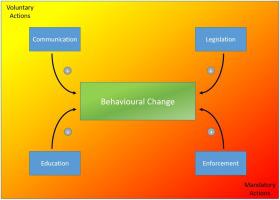Environmental Science & Policy ( IF 6 ) Pub Date : 2021-02-04 , DOI: 10.1016/j.envsci.2021.01.010 Fredrik Widemo

|
Achieving sustainability often requires fostering changes in norms and behaviours through a combination of restrictions and aware-raising activities. The phasing out of lead in ammunition to reduce lead poisoning in waterfowl provides a case in point. Twenty years after the Parties to the African Eurasian Waterbird Agreement (AEWA) committed to phase out lead shot in wetlands, such bans have been implemented in a third of Europe only. Furthermore, while evidence is scant, compliance varies widely where bans have been introduced. As a result, waterfowl are still suffering from lead poisoning.
Here, I survey the use of different types of shot while practicing and when taking game in different habitats in Sweden, one of the Parties to AEWA. Furthermore, I test the hypotheses that mandatory shooter education, or stakeholder communication, influence compliance with existing restrictions in Sweden, as well as the voluntary phasing out of lead shot where its use still is permitted.
More than half of the shooters practiced using lead and a third used lead shot over what they considered as wetlands, in both cases in violation of the current legislation. Furthermore, what constitutes a wetland appears to have been unclear to many shooters, especially in alpine areas. Both mandatory education and stakeholder communication were positively related to compliance.
Only 12–15 % used lead free alternatives in shooting over habitats where the use of lead shot is permitted. There was a weak positive relationship between stakeholder communication and the voluntary phasing out of lead shot, but no effect from education.
I suggest that the planned and ongoing phasing out of lead in ammunition should rest on a combination of legislation, enforcement, education and stakeholder communication in order to be successful. The findings add to our general understanding of how to turn environmental policy into sustainable management actions in practice.
中文翻译:

射击习惯和栖息地-教育和立法对逐步淘汰铅射击的影响
实现可持续性通常需要通过限制和提高认识活动相结合来促进规范和行为的改变。逐步淘汰弹药中的铅以减少水禽中的铅中毒就是一个很好的例子。非洲欧亚水鸟协定(AEWA)缔约方承诺逐步淘汰湿地铅铅事件二十年后,此类禁令仅在欧洲三分之一的国家实施。此外,尽管证据很少,但在实行禁令的地方,遵守情况差异很大。结果,水禽仍遭受铅中毒。
在这里,我调查了在AEWA缔约方之一的瑞典的不同生境中练习和比赛时不同类型投篮的使用情况。此外,我检验了以下假设:强制性射手教育或与利益相关者的沟通会影响瑞典对现有限制的遵守,以及在仍允许使用铅球的情况下自愿淘汰铅球。
在这两种情况下,超过一半的射手练习使用铅射击,而三分之一的人则在他们认为是湿地的地方使用铅射击,这两种情况均违反了现行法律。此外,对于许多射手,尤其是在高山地区,湿地的构成似乎还不清楚。强制性教育和与利益相关者的沟通均与合规性呈正相关。
在允许使用铅丸的栖息地进行射击时,只有12–15%的人使用了无铅替代品。利益相关者之间的沟通与自愿淘汰铅线索之间的积极关系较弱,但不受教育影响。
我建议,计划中的和正在进行的逐步淘汰弹药中的铅,应结合立法,执法,教育和利益相关方的沟通,以取得成功。这些发现加深了我们对如何将环境政策转化为实践中的可持续管理行动的一般理解。


























 京公网安备 11010802027423号
京公网安备 11010802027423号